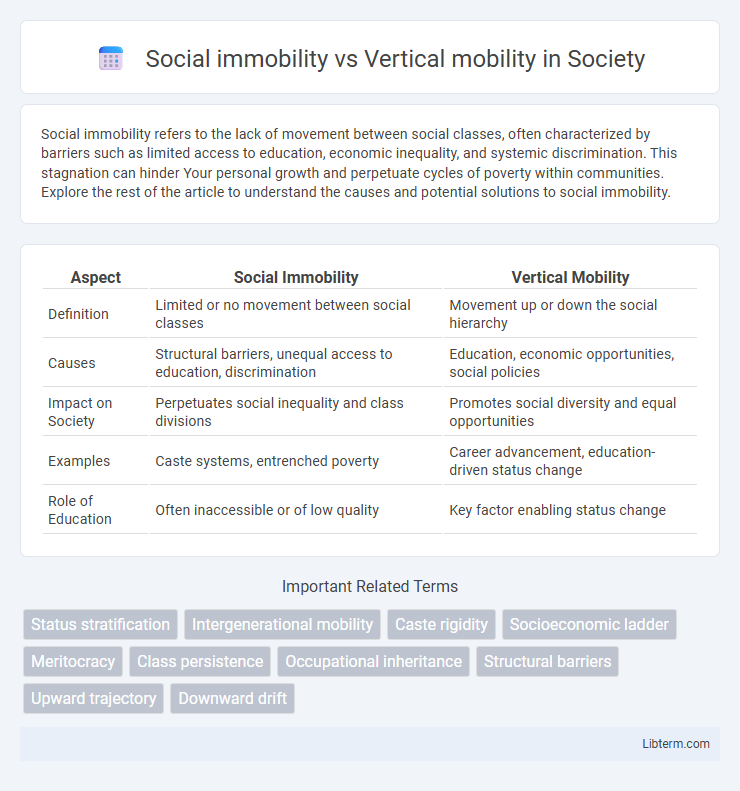Social immobility refers to the lack of movement between social classes, often characterized by barriers such as limited access to education, economic inequality, and systemic discrimination. This stagnation can hinder Your personal growth and perpetuate cycles of poverty within communities. Explore the rest of the article to understand the causes and potential solutions to social immobility.
Table of Comparison
| Aspect | Social Immobility | Vertical Mobility |
|---|---|---|
| Definition | Limited or no movement between social classes | Movement up or down the social hierarchy |
| Causes | Structural barriers, unequal access to education, discrimination | Education, economic opportunities, social policies |
| Impact on Society | Perpetuates social inequality and class divisions | Promotes social diversity and equal opportunities |
| Examples | Caste systems, entrenched poverty | Career advancement, education-driven status change |
| Role of Education | Often inaccessible or of low quality | Key factor enabling status change |
Understanding Social Immobility
Social immobility refers to the inability of individuals or groups to move between social strata, often due to structural barriers like limited access to education, economic resources, or social networks. This stagnation contrasts with vertical mobility, where people improve or decline in social status over time. Understanding social immobility highlights how entrenched inequalities persist, obstructing upward movement and perpetuating socioeconomic disparities.
Defining Vertical Mobility
Vertical mobility refers to the ability of individuals or groups to move up or down the social hierarchy, often measured by changes in occupation, income, or social status. It contrasts with social immobility, where individuals remain in the same social position throughout their lives, facing barriers to upward or downward movement. Factors influencing vertical mobility include education, economic opportunities, and social policies that facilitate or hinder access to higher social strata.
Key Differences Between Social Immobility and Vertical Mobility
Social immobility refers to the inability of individuals or groups to move between social strata, often due to structural barriers like poverty, discrimination, or lack of education. Vertical mobility involves the movement of individuals up or down the social hierarchy, measured by changes in occupation, income, or social status. Key differences include the presence of opportunity and change in socioeconomic position, with social immobility implying a stagnant status, while vertical mobility reflects dynamic social movement.
Historical Context of Social Mobility
Social immobility and vertical mobility have historically shaped societies by influencing individuals' ability to change their socioeconomic status across generations. In feudal systems, rigid class structures and hereditary privileges limited vertical mobility, reinforcing social immobility and maintaining elite dominance. Industrialization and modernization gradually expanded opportunities for vertical mobility, enabling shifts from agrarian to urban occupations and fostering social stratification changes.
Factors Influencing Social Immobility
Social immobility occurs when individuals or groups experience limited opportunities to change their socioeconomic status, often influenced by factors such as inherited wealth, access to quality education, and social networks. Vertical mobility, meanwhile, refers to the ability to move upward or downward in social hierarchy, which can be hindered by systemic barriers, discrimination, and unequal access to resources. Cultural capital, social policies, and economic structures play critical roles in either perpetuating social immobility or facilitating vertical mobility within society.
Drivers of Vertical Mobility in Society
Education level significantly drives vertical mobility by equipping individuals with skills and qualifications for higher-paying jobs. Economic factors such as industry growth and labor market demand create opportunities for ascending social classes. Family background and social networks also influence access to resources that enable upward movement within societal hierarchies.
The Role of Education in Social Mobility
Education serves as a critical driver of vertical mobility by equipping individuals with skills and credentials needed for upward social movement and improved economic status. In contrast, limited access to quality education perpetuates social immobility by reinforcing existing inequalities and hindering disadvantaged groups from climbing the social ladder. Policy interventions aimed at expanding educational opportunities can significantly enhance social mobility by breaking cycles of poverty and promoting equal chances for advancement.
Economic Impact of Social Immobility
Social immobility restricts individuals' ability to improve their economic status, leading to persistent income inequality and reduced labor market efficiency. This stagnation dampens overall economic growth by limiting human capital development and innovation potential. Economies experiencing high social immobility often face increased poverty rates and decreased consumer spending, hindering sustainable development.
Government Policies and Mobility Opportunities
Government policies play a crucial role in shaping social immobility and vertical mobility by determining access to education, healthcare, and employment opportunities. Social welfare programs, progressive taxation, and affirmative action initiatives can reduce barriers for disadvantaged groups, enhancing vertical mobility. Conversely, restrictive policies or inadequate investment in social infrastructure often reinforce social immobility by limiting upward mobility opportunities.
Strategies to Enhance Vertical Mobility
Implementing targeted education programs and vocational training significantly boosts vertical mobility by equipping individuals with marketable skills that lead to higher-paying jobs. Access to mentorship and professional networking opportunities fosters career advancement and helps break social immobility barriers. Policy reforms promoting equal employment opportunities and affordable higher education further enhance vertical social mobility by reducing systemic inequalities.
Social immobility Infographic

 libterm.com
libterm.com